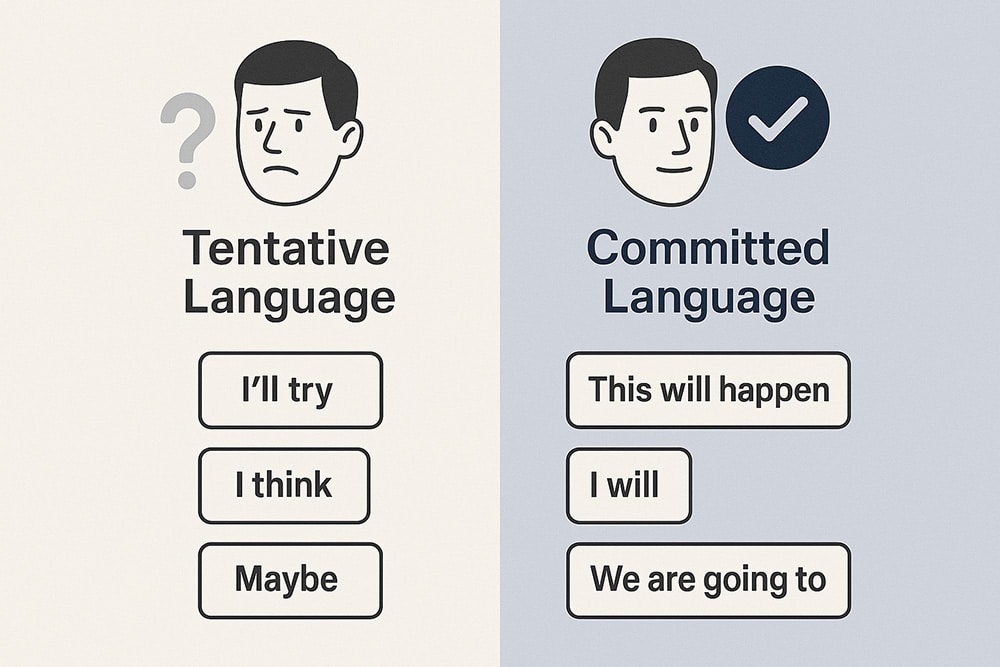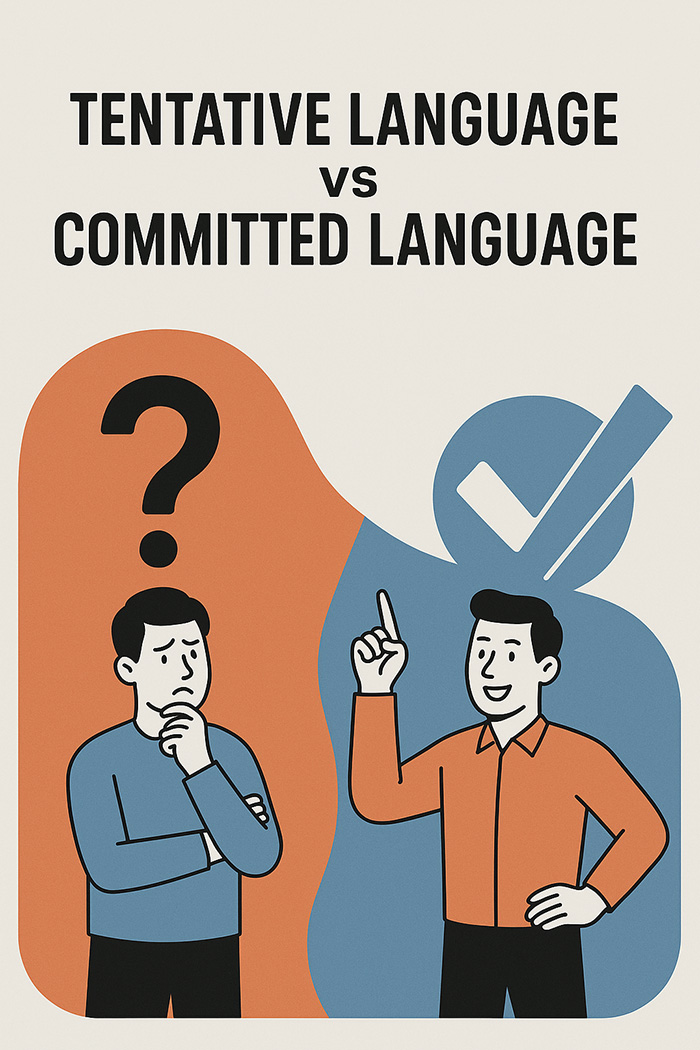Have you ever noticed how some leaders seem to create results out of thin air while others struggle to move the needle despite working twice as hard?
The difference often isn’t found in their strategies, intelligence, or even work ethic. It’s hidden in their language – specifically, whether they speak and then act with commitment or tentativeness when addressing the future.
Let me share what I witnessed in a fascinating leadership session that revealed this crucial distinction. A group of managers was exploring why they habitually used phrases like “I’ll try,” “I hope,” or “Let me see what I can do” – even when they fully intended to complete the task.
Their answers revealed something profound about how most of us operate:
“I’m buying time to make sure I can deliver.” “I don’t want to disappoint people if I can’t follow through.” “I’m avoiding taking full responsibility.” “I’m protecting myself from looking wrong.”
Sound familiar? These are the unconscious calculations we make dozens of times daily.
But here’s the twist: these seemingly harmless verbal cushions aren’t just communication quirks – they fundamentally shape how we think, act, and ultimately, what we achieve.
The Hidden Cost of “I’ll Try”
When you say “I’ll try” instead of “I will,” you’re not just being cautious. You’re unconsciously programming your mind and actions for uncertainty. This tentative language carries hidden costs:
- Mental burden and constant background stress
- Scattered attention and divided focus
- Lower productivity and action velocity
- More time spent in indecision and doubt
- Uncertainty for everyone involved
As one participant confessed: “When I say I’ll try, I end up working overtime to accommodate everything, constantly juggling priorities, and feeling perpetual stress because I’m not clear about what I’m fully committing to.”
Another revealed: “I find myself overthinking and second-guessing instead of just executing. It’s exhausting.”
These aren’t just personal inconveniences. They represent a massive tax on your leadership energy – energy that could be directed toward creating breakthrough results.

The Liberation of Clear Commitment
Now consider the alternative. What happens when you simply say “This will happen” or “I will deliver this” – even before you have all the evidence that you can?
The same participants described:
- Mental clarity and inner peace
- Heightened productivity
- Optimal use of time
- A healthier communication environment
- Faster, more decisive action
One leader noted: “When I commit clearly, I don’t waste time debating with myself. I just find a way to make it happen.”
This is the power of committed language – it creates a different foundation from which you operate and take action. Instead of waiting for certainty before committing, you commit first and then create the certainty through your actions.
The Courage to Look Wrong
At this point, you might be thinking: “But what if I commit and fail? Isn’t it more honest to say I’ll try?”
This is where courage enters the picture. The truth is, there’s no evidence in the future – only in the past. When you commit to something unprecedented, something you’ve never done before, you’re stepping into territory where failure is possible.
Most people avoid this risk at all costs. They want guarantees before they commit. But that’s precisely why most people don’t create extraordinary results.
Leaders who produce unprecedented outcomes understand a fundamental truth: commitment precedes evidence. They don’t wait for proof they can deliver before they commit – they commit first, then find a way to deliver.
Yes, sometimes they’re wrong. Sometimes they fail. But they understand that the occasional pain of being wrong is far less costly than the chronic pain of playing small.
The Two Operating Systems
Think of these approaches as two distinct operating systems for leadership:
Operating System 1: Evidence-Based Commitment
- Wait for evidence before committing
- Use tentative language to protect yourself
- Avoid disappointing others
- Reduce risk of being wrong
- Create predictable, incremental results
Operating System 2: Commitment-Based Evidence
- Commit first, then create the evidence
- Use clear, direct language
- Accept that some may be disappointed
- Accept the risk of being wrong
- Create unprecedented, breakthrough results
Most leaders operate exclusively in System 1. They believe it’s the only responsible way to lead. But what they don’t realize is that System 1 has built-in limitations – it can only produce results that are extensions of what’s already been done.
System 2 is where unprecedented results come from. It’s where you find the leaders who transform industries, redefine what’s possible, and create outcomes that seemed impossible before they arrived.

The Personal Challenge
One participant shared his personal struggle with this concept:
“I have a long history of blaming myself when things go wrong. I worry that if I commit strongly and then fail, I’ll spiral into self-blame.”
This is a legitimate concern. But notice what’s happening here – the fear of future self-blame is preventing bold commitment in the present.
The solution isn’t to avoid commitment. It’s to develop a healthier relationship with mistakes and failures. As this leader discovered, daily practice in reframing mistakes as learning opportunities gradually reduced his tendency toward self-blame.
He shared: “I started practicing positive daily declarations and focusing on what I can learn from mistakes rather than internalizing them. This has drastically reduced my stress and improved my productivity.”
This inner work is essential. You cannot speak with powerful commitment externally if you’re plagued by self-doubt and harsh self-judgment internally.
When to Say No
Another crucial aspect of committed language is learning to say a clean, clear “no” when appropriate.
One leader confessed: “I say ‘I’ll try’ when I actually want to say no, because I don’t want to hurt or disappoint people.”
This is where empathy without authenticity becomes weakness. When you say “I’ll try” instead of “no,” you’re not being kind – you’re being unclear. You’re creating false hope and ultimately more disappointment than a clear no would have caused.
“Empathy without authenticity is weakness. Leadership is doing what is required, not what is easy.”
A clean no is far more respectful than a vague, uncommitted maybe. It allows the other person to make clear decisions based on accurate information rather than false hope.
The Practice of Commitment
Transforming your language from tentative to committed isn’t an overnight change. It’s a practice – one that feels uncomfortable at first, especially if you’ve spent years or decades operating from System 1.
Here’s how to begin:
- Notice your language patterns. Pay attention to how often you say “I’ll try,” “I hope,” or “Let me see.” Just observing these patterns creates awareness.
- Start with low-stakes commitments. Practice committed language in areas where the consequences of failure are minimal. This builds your comfort with commitment.
- Examine your fears. When you catch yourself using tentative language, ask: “What am I afraid might happen if I commit clearly here?”
- Separate identity from outcomes. Remember that failing at something doesn’t make you a failure. It makes you someone who took a risk.
- Create morning intentions. As one participant shared: “I write down my intentions for the day – how I want to show up, what I’m committed to accomplishing. This primes my mind for clear commitment.”
The Leadership Choice
Every day, in countless conversations, you choose how you’ll speak about the future. Most of these choices happen unconsciously, driven by habits and fears you may not even recognize.
But now you have a choice. You can continue operating exclusively from System 1 – waiting for evidence before committing, protecting yourself from being wrong, and creating predictable results.
Or you can begin incorporating System 2 – committing before you have all the evidence, accepting the risk of being wrong, and creating the possibility of unprecedented outcomes.
This isn’t about abandoning careful thinking or responsible planning. It’s about recognizing that for the results that matter most – the breakthrough innovations, the transformative changes, the unprecedented achievements – commitment must precede certainty.
The Spectrum of Commitment
It’s worth noting that this isn’t an all-or-nothing proposition. You don’t have to commit with absolute certainty to everything. Think of it as a spectrum:
- For routine, low-impact decisions: Your habitual approach may work fine
- For moderate-impact decisions: Consider more committed language
- For high-impact, transformative goals: Full commitment is essential
I’m not asking you to jump totally to committed language for everything. But for the things that matter, for the results that matter, you commit. And yes, you can be wrong. And that’s the cost of taking on any big game.
Your Unprecedented Future
Look at the goals you’re currently pursuing. The ones that really matter. The ones that would transform your leadership, your organization, or your life.
Now ask yourself honestly: Am I speaking about these goals with committed language or tentative language?
Am I saying “I’ll try to hit our targets” or “We will hit our targets”?
Am I saying “I hope to transform our culture” or “I will transform our culture”?
Am I saying “Let’s see if we can innovate” or “We will innovate”?
The difference may seem subtle, but it’s everything. In that small linguistic gap lies the difference between leaders who manage the status quo and leaders who create new realities.
The Time for Commitment
Most of us have been conditioned to believe that certainty should precede commitment – that we should only promise what we’re already certain we can deliver.
But that approach has built-in limitations. It confines you to the realm of the proven, the established, the already-done. It makes unprecedented results impossible by definition.
The greatest leaders throughout history have operated differently. They committed to outcomes that seemed impossible at the time:
- Landing on the moon before the technology existed
- Creating computers that fit in our pockets before the components were invented
- Building electric vehicles viable for mass markets before the infrastructure was in place
None of these commitments were “reasonable” when they were made. All required their leaders to stand in a place of commitment before evidence existed.
You have this same power available to you right now. The power to commit to a future that doesn’t yet exist – and through that commitment, begin creating it.
Yes, you might be wrong sometimes. Yes, you might disappoint people occasionally. Yes, you might look foolish in the eyes of those who operate solely from System 1.
But you also might create something unprecedented – something that changes everything.
Isn’t that possibility worth the risk?
The Choice Before You
So here’s the invitation: Choose one important goal – something that matters deeply to you, something that would represent a breakthrough in your leadership or organization.
Now, how do you speak about this goal? With tentative, cautious language? Or with clear, committed language?
If you’re like most leaders, you’ve been operating from System 1 – waiting for certainty before committing. That’s not wrong, but it is limiting.
What would happen if you shifted to System 2 for this one crucial goal? If you spoke with commitment before you had all the evidence? If you said “This will happen” instead of “We’ll try to make this happen”?
You might fail. You might be wrong. You might disappoint yourself or others.
Or you might create something unprecedented – something that changes everything.
The choice is yours.
Your future is waiting.
